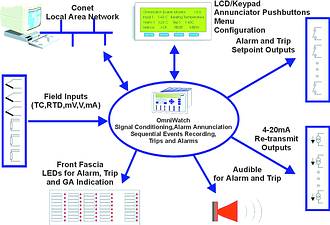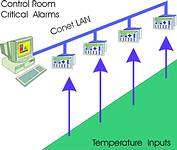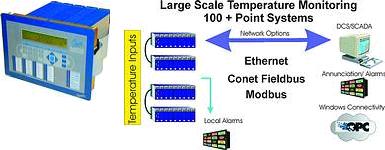
Whether they are needed for 1 point, 16 points - or 600 points or more, Omniflex temperature monitoring solutions come with high-end specifications, providing cost effective solutions. Critical temperatures with a plant or process have the potential to cause or inflict tremendous loss if not monitored and controlled. Also important is the time of occurrence of temperature fluctuations in monitoring and improving plant or process effectiveness and understanding the dynamics of the process under examination. Compatibility of the front-end temperature measuring system with a variety of supervisory systems is important.
Omniflex offers a new generation temperature monitoring system catering for up to 16 temperatures at once. No multiplexing and no rotary switches. Temperature inputs may be any 3-wire RTD or thermocouples and these are pre-programmed options. Cold junction compensation and linearisation are all standard features.

Alarms and alarm annunciation
Each temperature input has an alarm and trip setpoint allocated to it. Setpoints are configurable via the front panel keypad. Each setpoint is represented by an LED indicator, which can be configured with an optional enunciator sequence forcing an operator to silence the audible, and acknowledge the flashing alarm LED. An auto reset or manual reset option can be chosen so that alarms can be trapped in applications where operators may not be present at all times.
Temperature channel display
Each temperature channel may be viewed in turn on the front panel LCD display with its setpoints by using a scroll button. An option to automate the display so that the display automatically scrolls through the channels at a specified time interval is also a useful option where the units are mounted behind glass or polycarbonate in harsh environments.
Optional individual alarm and trip outputs
Each setpoint should have the option for a relay or open collector output for the alarm or trip status; these can be used to drive external devices when the setpoints are reached, providing early warning and protection to the process or device being monitored.
Group alarm function
To save on relay outputs in certain applications, group alarm functions are used to bring up the alarm for the attention of operators or to provide trip protection functionality. Four group alarms are necessary - one each for setpoint 1(alarms) and setpoint 2(trips) - and one each to function as a high-high or low-low group alarm. Every input is mapped to the group alarms.
Optional re-transmit
The temperature inputs can be re-transmitted to another device as 4-20 mA outputs by simply fitting an analog re-transmit output module if required.
Date and time stamp of alarms
Every alarm or trip is date and time stamped as it occurs. This is imperative where unmanned stations are visited periodically and the recording of alarm and trips present an audit trail of what happened. These events need to be available to a network which can then route them to a scada database system for further analysis.
Local history log
A local history log, which captures the last 64 trips and alarms with its date and time stamp is necessary to review and audit what has happened and this needs to be viewed via the front panel of the unit. Operators thus have access to the latest information local to the process.

Local area network connections and supervisory systems
Networking on existing twisted pair cabling in the plant makes for easy retrofitting. Multidropping up to 126 devices along a single twisted pair cable will provide the capacity a total of 2016 temperature channels on a single twisted pair cable. Ethernet gateways supervisory systems are available and OPC servers allow most scada packages to acquire the information from field devices, including all date and time stamped information. Predictive and preventive maintenance systems can then utilise the data for pro-active plant management.
The Omniflex temperature monitoring system, OmniWatch, has the following features all in one unit:
* 16 temperature channels.
* Alarm annunciation/indication for temperature alarms and trips (32 indicators).
* Display in degrees C or F.
* Front panel configuration or via PC.
* Re-transmit option (4 to 20 mA) for temperature inputs.
* Group alarm and trip facility.
* Optional independent alarm and trip outputs.
* Date and time stamp of alarms.
* History log of last 64 alarms and trips.
* Up to 126 OmniWatch units on a twisted pair.
* Scada and OPC compatible.

Large-scale applications
Larger scale applications use the same Maxiflex solutions, but the scale of the application often means that visual indication is in the domain of HMIs or scada DCS systems. Functionality of the system is varied and tailored to the application's needs. This is easily delivered by Maxiflex and a variety of local area network communications solutions, including Ethernet, to get the information back to supervisory systems. Local alarm and centralised alarm indication can be implemented with ease. Integration into Windows operating systems via OPC servers gives access to most scada packages on the market.
Typical larger applications would include:
* Boilers and boiler skin temperatures.
* Kilns and rotary kilns.
* Reactor/cracker temperature monitoring.
* Plastics moulding.
* Furnace.
* Temperature profiles and curing.
Building upon the 35 plus years of experience in the field of alarm and events monitoring instrumentation for industry, Omniflex continues to provide solutions for many plant applications such as temperature monitoring.
For more information contact Ian Loudon, Omniflex, 031 207 7466, [email protected], www.omniflex.com
| Tel: | +27 31 207 7466 |
| Email: | [email protected] |
| www: | www.omniflex.com |
| Articles: | More information and articles about Omniflex Remote Monitoring Specialists |
© Technews Publishing (Pty) Ltd | All Rights Reserved